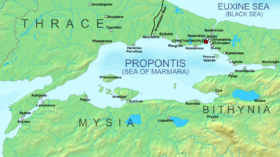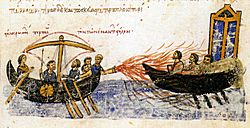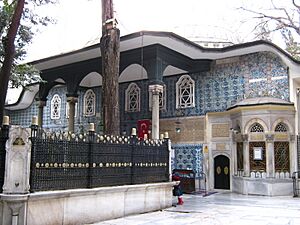Siege of Constantinople (674–678) facts for kids
Quick facts for kids First Arab siege of Constantinople |
|||||||
|---|---|---|---|---|---|---|---|
| Part of the Arab–Byzantine wars | |||||||
 Map of the environs of Constantinople in Byzantine times |
|||||||
|
|||||||
| Belligerents | |||||||
| Umayyad Caliphate | Byzantine Empire | ||||||
| Commanders and leaders | |||||||
| Yazid ibn Mu'awiya Sufyan ibn Awf † Junada ibn Abi Umayya Fadala ibn Ubayd |
Constantine IV | ||||||
| Strength | |||||||
| 200,000 | 40,000 | ||||||
| Casualties and losses | |||||||
| 100,000 killed | 5,700 | ||||||
The First Arab Siege of Constantinople happened between 674 and 678. It was a big battle in the Arab–Byzantine wars. The Umayyad Caliphate, led by Caliph Mu'awiya I, wanted to expand their empire. Mu'awiya became ruler after a civil war in 661. He decided to attack the Byzantine Empire again. His main goal was to capture Constantinople, the Byzantine capital city.
A Byzantine writer named Theophanes the Confessor said the Arab attack was well-planned. In 672–673, Arab ships took control of bases along the coast of Asia Minor. Then, they slowly blocked Constantinople. They used the Cyzicus peninsula as a winter camp. Each spring, they would return to attack the city's strong fortifications.
Finally, the Byzantines, led by Emperor Constantine IV, defeated the Arab navy. They used a new secret weapon called Greek fire. This was a liquid that could burn on water. The Byzantines also beat the Arab army on land in Asia Minor. This forced the Arabs to stop their attack.
This Byzantine victory was very important. It helped the Byzantine Empire survive. The Arab threat became smaller for a while. A peace treaty was signed soon after. Another civil war started among the Muslims. This allowed the Byzantines to become stronger than the Caliphate for a short time. This siege was the first major defeat for the Arabs in 50 years of expanding their empire. It helped stabilize the Byzantine Empire after many years of war.
Stories about the siege became legends in the Muslim world. But sometimes, these stories mix up this siege with another attack in 669. That earlier attack was led by Mu'awiya's son, Yazid. Because of this, some modern historians have questioned Theophanes' story. They have looked at Arabic and Syriac writings. These sources give different ideas about when the siege happened or if it happened exactly as described. However, news of a big siege and a peace treaty even reached China. It was written down in the histories of the Tang dynasty.
Contents
Why the Siege Happened
After a terrible battle called the Battle of the Yarmuk in 636, the Byzantine Empire pulled most of its soldiers back. They moved them from the Levant to Asia Minor. The Taurus Mountains protected Asia Minor from the Muslim armies. This allowed the new Rashidun Caliphate to finish conquering Syria. Egypt also fell to them soon after.
Muslim raids into Cilicia and deep into Asia Minor started as early as 640. These attacks continued under Mu'awiya, who was then the governor of the Levant. Mu'awiya also started building a Muslim navy. In just a few years, this navy became strong enough to take Cyprus. It also raided islands like Kos, Rhodes, and Crete in the Aegean Sea.
In 655, the young Muslim navy won a huge victory. They defeated the Byzantine navy in the Battle of the Masts. But then, the Muslim civil war started after Caliph Uthman was killed. Arab attacks against Byzantium stopped. In 659, Mu'awiya even made a truce with Byzantium. He agreed to pay tribute to the Empire.
The peace lasted until the Muslim civil war ended in 661. Mu'awiya and his family won, creating the Umayyad Caliphate. The next year, Muslim attacks started again. Muslim armies began spending winters in Byzantine lands west of the Taurus mountains. This caused a lot of problems for the Byzantine economy. Sometimes, these land attacks were combined with naval raids along the southern coasts of Asia Minor.
In 668, the Arabs helped Saborios, a Byzantine general who had rebelled. But the Arab troops arrived too late. Saborios had died after falling from his horse. The Arab soldiers spent the winter near Melitene, waiting for more troops.
In spring 669, more Arab troops arrived. They advanced to Chalcedon, which was across the Bosporus from Constantinople. The Byzantines fought off the Arab attacks on Chalcedon. The Arab army suffered greatly from hunger and sickness. Mu'awiya sent another army, led by his son Yazid, to help.
Stories about what happened next are different. The Byzantine writer Theophanes says the Arabs stayed near Chalcedon for a while. Then they went back to Syria. On their way, they captured Amorium. This was the first time the Arabs tried to hold a captured fort deep inside Asia Minor. It probably meant they planned to use it as a base next year. But the Byzantines took Amorium back that winter. Arab writers, however, say the Muslims crossed into Europe and attacked Constantinople itself. But they failed and returned to Syria. Since Byzantine sources don't mention such an attack on Constantinople, it's likely the Arab writers "upgraded" the attack on Chalcedon to an attack on the capital. This was probably because Yazid was there and Chalcedon is very close to Constantinople.
Preparing for the Big Attack
The 669 campaign showed the Arabs they could attack Constantinople directly. But they also needed a supply base nearby. They found this base on the Cyzicus peninsula, on the southern shore of the Sea of Marmara. A raiding fleet spent the winter there in 670 or 671. Mu'awiya then began to plan his final attack on the Byzantine capital.
This time, Mu'awiya planned to reach Constantinople by sea. His plan was careful and step-by-step. First, the Muslims had to secure strong points and bases along the coast. Then, using Cyzicus as their main base, they would block Constantinople by land and sea. This would cut off the city from its food supply.
So, in 672, three large Muslim fleets were sent out. Their job was to secure the sea routes and set up bases between Syria and the Aegean Sea. One fleet spent the winter at Smyrna. Another fleet wintered in Lycia and Cilicia. A third fleet joined them later.
According to Theophanes, Emperor Constantine IV (who ruled from 661 to 685) heard about the Arab fleets. He began preparing his own navy for war. Constantine's ships had special tubes for firing a new burning liquid. This was the famous Greek fire.
In 673, another Arab fleet captured Tarsus in Cilicia and also Rhodes. Rhodes was halfway between Syria and Constantinople. It became a forward supply base for the Muslims. It also became a center for their naval raids. A group of 12,000 soldiers was stationed there. They were regularly sent back to Syria and replaced. A small fleet was also kept there for defense and raiding. The Arabs even planted wheat and brought animals to graze on the island. The Byzantines tried to stop the Arab plans by attacking Egypt by sea, but they failed. During this time, land raids into Asia Minor continued. Arab troops spent the winter in Byzantine territory.
The Siege and Battles (674–678)
In 674, the Arab fleet sailed from its bases in the eastern Aegean. They entered the Sea of Marmara. Theophanes says they landed on the Thracian shore in April. They fought constantly with Byzantine troops until September. The Byzantine writer reported, "Every day there was a military engagement from morning until evening." The fighting happened near the Golden Gate of Constantinople.
Then, the Arabs left and went to Cyzicus. They captured it and turned it into a fortified camp for the winter. This became the pattern for the siege. Each spring, the Arabs would cross the Marmara and attack Constantinople. Then they would go back to Cyzicus for the winter. The "siege" was really a series of battles around the city. It might even include Yazid's attack in 669.
Both Byzantine and Arab writers say the siege lasted seven years, not five. This could mean they included the early campaigns of 672–673. Or it could mean they counted until the Arab troops finally left their bases in 680.

The details of the battles around Constantinople are not very clear. Theophanes combines the events of the siege into his story of the first year. Arab writers don't mention the siege at all. They only give names of leaders who went on expeditions into Byzantine lands. From Arab sources, we know that some Arab leaders raided Crete in 675. Another leader led a raid into Asia Minor that same year. Arab historians also say that Yazid was sent with more troops to Constantinople in 676.
While the Byzantines were busy fighting the Arabs, other problems arose. In Italy, the Lombards took over most of Calabria. In the Balkans, Slavic tribes attacked Thessalonica. They also launched sea raids in the Aegean, even reaching the Sea of Marmara.
Finally, in late 677 or early 678, Emperor Constantine IV decided to fight the Arab attackers directly. His fleet, armed with Greek fire, completely defeated the Arab fleet. It's likely that the death of the Arab admiral Yazid ibn Shagara in 677/678 is linked to this defeat. Around the same time, the Muslim army in Asia Minor was defeated by the Byzantine army. Theophanes says the Arabs lost 30,000 men. These defeats forced the Arabs to give up the siege in 678. On their way back to Syria, the Arab fleet was almost completely destroyed in a storm.
A Byzantine poem from the early 700s also talks about a big naval victory near Constantinople. It even mentions that the Arab fleet also had fire-throwing ships. This poem supports Theophanes' story. It also mentions "the fear of their returning shadows," which might mean the Arabs attacked every spring from Cyzicus.
Why This Victory Was Important
Constantinople was the heart of the Byzantine Empire. If it had fallen, the rest of the empire would likely have broken apart. It would have been easy for the Arabs to conquer. So, the failure of the Arab attack was a huge event. It was the end of Mu'awiya's long campaign to wear down the Byzantines. He had spent huge amounts of money and effort, including building a massive fleet.
The failure of the siege was a big blow to the Caliph's reputation. On the other hand, Byzantine prestige grew greatly, especially in the West. Emperor Constantine IV received visitors from the Avars and the Balkan Slavs. They brought gifts and congratulations, recognizing Byzantine power. The peace that followed also gave Asia Minor a much-needed break from constant raids. It allowed the Byzantine Empire to recover and become strong again after many difficult years.
The Arabs' failure at Constantinople happened at the same time as a Christian group called the Mardaites became more active. They lived in the mountains of Syria and fought against Muslim control. They raided the lowlands. Facing this new threat and after their huge losses against the Byzantines, Mu'awiya started talking about a truce. Talks between the two sides lasted until 679. This gave the Arabs time for one last raid into Asia Minor, perhaps to put pressure on the Byzantines.
The peace treaty was supposed to last for 30 years. The Caliph agreed to pay the Byzantines an annual tribute. This included 300,000 gold coins, 50 horses, and 50 slaves. The Arab soldiers were pulled out of their bases on the Byzantine coast, including Rhodes, in 679–680.
Soon after the Arabs left his capital, Constantine IV sent an army against the Slavs near Thessalonica. He stopped their piracy, helped the city, and brought the area back under imperial control. After making peace, he then moved against the growing threat from the Bulgars in the Balkans. But his huge army was badly defeated. This allowed the Bulgar state to be formed in the northeastern Balkans.
In the Muslim world, Mu'awiya died in 680. Different groups within the Caliphate started to fight. The Caliphate split during the Second Muslim Civil War. This allowed Byzantium to have peace and become very powerful on its eastern border. Armenia and Iberia came back under Byzantine control for a while. Cyprus became a shared territory between Byzantium and the Caliphate.
The peace lasted until Constantine IV's son, Justinian II, broke it in 692. This had terrible results. The Byzantines were defeated, and Justinian was removed from power. A twenty-year period of chaos followed. Muslim attacks became more frequent. This led to a second Arab attempt to conquer Constantinople in 717–718, which also failed.
Cultural Impact and Legends
Later Arab writings talk a lot about Yazid's 669 expedition and the supposed attack on Constantinople. They include many mythical stories. Modern historians believe these stories actually refer to the events of the 674–678 siege. Several important early Muslim figures are mentioned as taking part. These include Ibn Abbas, Ibn Umar, and Ibn al-Zubayr.
The most famous person in these later stories is Abu Ayyub al-Ansari. He was one of the early companions of Muhammad and his standard-bearer. He died of illness outside the city walls during the siege and was buried there. Muslim tradition says that Constantine IV threatened to destroy his tomb. But the Caliph warned that if he did, Christians living under Muslim rule would suffer. So, the tomb was left alone. It even became a place of respect for the Byzantines, who prayed there during droughts.
The tomb was "rediscovered" after the Fall of Constantinople to the Ottoman Turks in 1453. This was done by a dervish named Sheikh Ak Shams al-Din. Sultan Mehmed II (who ruled from 1444–1446 and 1451–1481) ordered a marble tomb and a mosque to be built next to it. It became a tradition that Ottoman sultans were given the Sword of Osman at the Eyüp mosque when they became ruler. Today, it is still one of the holiest Muslim shrines in Istanbul.
This siege is even mentioned in the Chinese histories of the Old Book of Tang and New Book of Tang. They say that the large, well-fortified capital city of Fu lin (which means Byzantium) was attacked by the Da shi (which means the Umayyad Arabs). Their commander was "Mo-yi," who has been identified as Mu'awiya. The Chinese histories then explain that the Arabs forced the Byzantines to pay tribute as part of a peace agreement. In these Chinese sources, Fu lin was directly related to the earlier Daqin, which modern experts believe was the Roman Empire.
New Ideas About the Events
The story of the siege that most historians accept today comes mostly from Theophanes' account. However, Arab and Syriac sources don't mention a single siege. Instead, they talk about individual campaigns. Only a few of these campaigns reached Constantinople. For example, the capture of an island called Arwad "in the sea of Constantinople" is recorded for 673/674. But it's not clear if this refers to the Sea of Marmara or the Aegean Sea. Yazid's expedition in 676 is also said to have reached Constantinople.
Syriac writers also disagree with Theophanes about when the big battle happened. They say the Arab fleet was destroyed by Greek fire in 674. This happened during an Arab attack on the coasts of Lycia and Cilicia, not at Constantinople. After that, Byzantine forces landed in Syria in 677/678. This started the Mardaite uprising, which threatened the Caliphate's control over Syria. This led to the peace agreement in 678/679.
Some historians, like James Howard-Johnston, have looked at the original sources again. In his 2010 book, he rejects the traditional story from Theophanes. He prefers the version from the Syriac writers. Howard-Johnston believes that a siege didn't actually happen. He points out that eastern sources don't mention it. He also thinks such a long siege would have been too difficult to supply. Instead, he believes the idea of a siege was added later. It might have been influenced by the second Arab siege in 717–718.
Howard-Johnston says, "The blockade of Constantinople in the 670s is a myth." He thinks it hides the real success the Byzantines had. This success came from naval victories and an uprising that worried the Arabs.
However, another historian, Marek Jankowiak, argues that a major Arab siege did happen. But he believes Theophanes, who wrote about 140 years later, got the dates and events mixed up. Jankowiak suggests the siege should be dated to 667–669. He thinks the main attack happened in the spring of 668.
Images for kids




